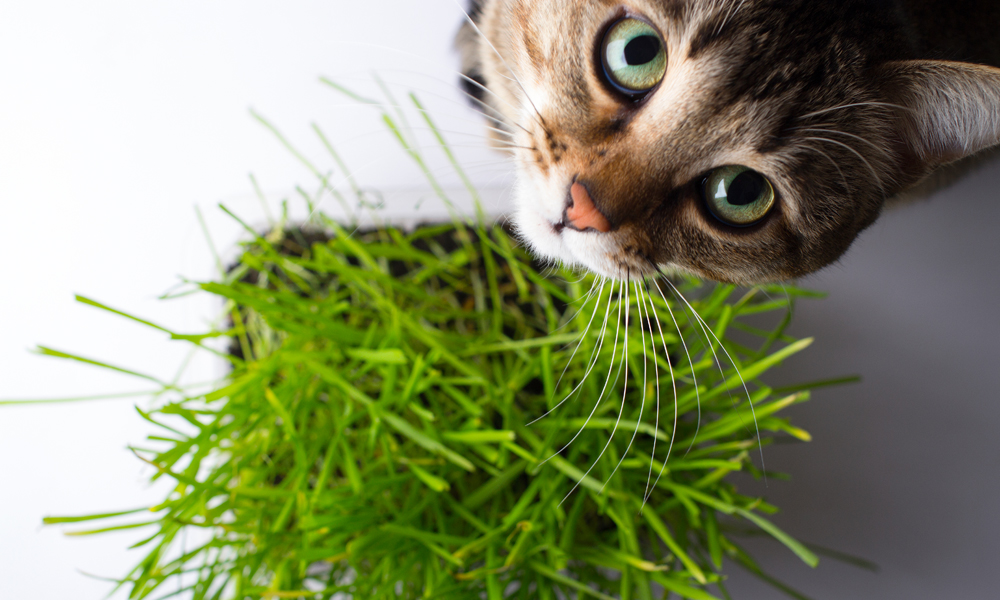Living life inside is great for your cat’s long-term health and longevity, and indoor plant play fulfills many feline instincts. Outdoors, a cat will certainly check out and nibble at an appealing plant they find on their rounds, even though they’re considered carnivores. Why do they do this? Norwegian researchers conclude that a cat’s urge to eat plants comes from an ancestral habit that served a purpose, to expel intestinal parasites.
Kitty’s habit of treating your potted plants like their midday snack station may annoy and alarm you, but when you think about it, this is typical cat behavior.
We’ll talk about how to get your cat to stop this destructive behavior, along with which plants are safe for cats (as well as dogs) and which are toxic and should be kept out of the house.
How do you keep cats away from houseplants?
The short answer here is that it’s unlikely you can convince your cat to leave your plants alone. The urge to dissuade kitty from targeting your plants is an understandable one. But that may not be the best approach for your cat. First of all, playfully batting at fronds and leaves, pawing at the dirt, and biting off stems satisfies your cat’s instincts to play, dig, explore and chew. Plus, while there are tricks you can try, there’s no such thing as a foolproof method that teaches cats to keep their distance from plants.
That brings us to toxic plants. While many houseplants don’t hurt cats when eaten, there are plenty that do. You can’t count on feline senses to tell between a safe plant and toxic plant. Our houseplants come from almost all continents, lands far from early ancestors of domestic cats. How would they know?
So here’s the solution: If a plant is deemed toxic, or is causing stomach upset and other signs of distress, why take a gamble on your cat’s health while attempting to change his behavior? Keep the plant in a room that your cat can’t enter, or rehome the plant to a pet-free house. It’s best for kitty’s health, and you’ll feel less stressed.
Which plants are toxic to cats?
The following is a partial list of common house plants that are toxic, or in some cases, deadly to cats when ingested. (The same is true for dogs, in most cases.) So if your pet has access to any of these and shows signs of skin irritation, stomach upset, vomiting, lethargy, excess drooling or salivation, bring them to a vet immediately.
- Asparagus fern
- Azalea
- Begonia
- Heartleaf philodendron (Animal may exhibit excess drooling, and have difficulty swallowing.)
- Lily including the peace lily, tiger lily, calla lily and Easter lily (Ingestion can cause kidney failure in cats, so keep these plants out of your house.)
- Sago palm (Ingestion can cause liver damage and be fatal.)
- Spring bulbs (like tulips)
- Succulents (These little plants are having a moment as home décor, but some are toxic, including aloe vera, jade, pencil cactus, and kalanchoes.)
- Weeping fig (also known as the Indian rubber plant)
This is not a comprehensive list. To make sure your houseplant situation is pet safe, identify all the plants you have in the house, and check them against the Toxic and Non-Toxic Plants List maintained by the ASPCA. If you’re not sure, get an expert opinion. Your local garden center, a plant ID app or even your pet’s health care provider are potential resources.
Cat-friendly plants for the house
Catnip, the classic cat stimulant, is the ultimate cat-friendly plant you can grow in your house. Cats love chewing on the leaves for an energy spike and the good-mood vibes, while you can still enjoy the look of foliage in your kitchen window. Win-win! But if your cat doesn’t care for the stuff, or you’d like to dress up your home with cat-friendly foliage, here are a couple of options:
Cat grasses
Some pet retailers sell seed blends or potted starters for grasses cats enjoy chewing on. These include rye, wheat and oat. Visit your independent brick-and-mortar pet shop in your community for ideas. Plant them in a pretty (but shatter-proof) pot and let them adorn your house and satisfy your cat.
Herbs
Besides catnip, there are several herbs you can try growing that appeal to some cats (without causing them harm), while filling your house with appealing scents. Cat thyme provides an alternative for cats that don’t get stimulated by catnip. You can also try lemongrass, a mild cat stimulant, as well as valerian root (which humans use for its calming properties), and silvervine and licorice root.
Houseplants that are non-toxic to cats
Once your feline friend starts giving cat grasses and other cat-safe foliage a try, think about bringing other plants back into the house. We love cats because we can’t always predict what they’ll do or how they’ll behave. But if they have a plant or two to call their own and enjoy having them, maybe they’ll decide to ignore the other growing things in your house.
If your cat (or dog) has trouble staying away from plants, it’s important to know that even a non-toxic plant can cause vomiting and other tummy issues. Rather than call these plants safe, it’s probably more accurate to use “non-toxic,” as they are unlikely to trigger a serious reaction that makes your pet ill.
For example, the spider plant has bouncy fronds called “spiderettes” that cats find difficult to resist batting and, eventually, eating. Though listed as non-toxic, many believe the spider plant has a mild hallucinogenic effect on cats. But one thing is certain, and it’s that spider plants can cause stomach upset and vomiting when eaten.
[Learn why dogs eat grass and what you can do to stop them.]
The following is a list of plants that are deemed non-toxic for dogs and cats, according to ASPCA.
- African violets
- Areca palm
- Baby rubber plant
- Baby’s tears (can cause mild vomiting and diarrhea)
- Boston fern
- Christmas cactus
- Parlor palm
- Ponytail palm
- Prayer plant
- Succulents (While some are toxic (see above) many others are pet safe, including blue echeveria (aka hen and chicks), burro’s tail, Mexican rosettes, copper rose, plush plant, tree cactus and wax rosettes.)
- Wax plant
Life with cats is always interesting given their inquisitive natures and penchant to play. But if your houseplants are the target of their explorations, changing out your indoor flora restore peace to your house.
For a healthy, happy cat, feed them a diet that keeps their gut ecosystem in balance, so they can better absorb vital nutrients and keep their immune system functioning at its best. At NutriSource, we formulate all our pet diets with our innovative Good 4 Life® system that builds good gut health. Find NutriSource at your local, independent pet retailer.


